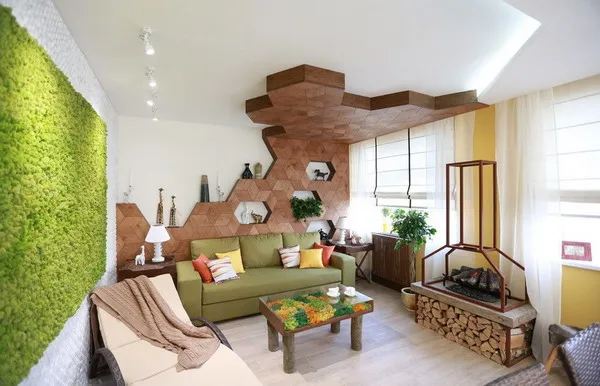As the world continues to grapple with the challenges of climate change, sustainability has become a top priority for businesses and individuals alike. One area that is often overlooked in the quest for eco-friendliness is the humble ceiling. However, with the rise of sustainable building materials and innovative technologies, eco-friendly ceilings are set to take center stage in 2025.
The Problem with Traditional Ceilings
Traditional ceilings are often made from materials such as drywall, plywood, and acoustic tiles, which are not only non-renewable but also contribute to indoor air pollution and waste. In fact, a typical ceiling can contain up to 30% of the total building materials used in a construction project, making it a significant area for improvement.
The Benefits of Eco-Friendly Ceilings
Eco-friendly ceilings offer a range of benefits that make them an attractive option for businesses and homeowners alike. Some of the key advantages include:
-
- Reduced Environmental Impact: Eco-friendly ceilings are made from sustainable materials that are sourced locally and manufactured using environmentally friendly processes. This reduces the carbon footprint of the ceiling and helps to minimize waste.
-
- Improved Indoor Air Quality: Eco-friendly ceilings can be designed to improve indoor air quality by incorporating natural ventilation systems and air-purifying materials.
-
- Increased Energy Efficiency: Eco-friendly ceilings can be designed to reduce energy consumption by incorporating insulation materials and reflective coatings that help to reduce heat gain in the summer and heat loss in the winter.
-
- Cost Savings: Eco-friendly ceilings can be more cost-effective than traditional ceilings in the long run, as they require less maintenance and can help to reduce energy costs.
Innovative Eco-Friendly Ceiling Materials
Several innovative eco-friendly ceiling materials are emerging as popular options for sustainable building projects. Some of the key materials include:
-
- Bamboo Ceilings: Bamboo is a highly renewable and sustainable material that can be used to create a range of ceiling designs. Bamboo ceilings are lightweight, durable, and can be finished with a variety of coatings and paints.
-
- Recycled Plastic Ceilings: Recycled plastic ceilings are made from post-consumer plastic waste that is collected, sorted, and processed into a range of ceiling material. This reduces waste and helps to conserve natural resources.
-
- Natural Fiber Ceilings: Natural fiber ceilings are made from sustainable materials such as hemp, jute, and sisal. These materials are biodegradable, non-toxic, and can be used to create a range of ceiling designs.
-
- Acoustic Ceilings: Acoustic ceilings are designed to improve sound quality and reduce noise pollution. They can be made from a range of eco-friendly materials, including recycled plastic and natural fibers.
Design Considerations for Eco-Friendly Ceilings
When designing an eco-friendly ceiling, several factors need to be considered to ensure that the ceiling meets the needs of the building and its occupants. Some of the key design considerations include:
-
- Aesthetics: Eco-friendly ceilings can be designed to be visually appealing and can be finished with a range of coatings and paints to match the desired aesthetic.
-
- Acoustics: Eco-friendly ceilings can be designed to improve sound quality and reduce noise pollution.
-
- Functionality: Eco-friendly ceilings can be designed to provide additional functionality, such as natural ventilation systems and air-purifying materials.
-
- Maintenance: Eco-friendly ceilings can be designed to be low maintenance and easy to clean.
The Future of Eco-Friendly Ceilings
As the demand for sustainable building materials continues to grow, eco-friendly ceilings are set to play a major role in the future of construction. With the rise of innovative materials and technologies, eco-friendly ceilings are becoming a viable option for businesses and homeowners alike.
Conclusion
Eco-friendly ceilings are an important step towards creating a more sustainable future. By incorporating sustainable materials and innovative technologies, eco-friendly ceilings can help to reduce the environmental impact of construction projects and improve indoor air quality. As the demand for sustainable building materials continues to grow, eco-friendly ceilings are set to play a major role in the future of construction.
FAQs
Q: What are the benefits of eco-friendly ceilings?
A: Eco-friendly ceilings offer a range of benefits, including reduced environmental impact, improved indoor air quality, increased energy efficiency, and cost savings.
Q: What are some innovative eco-friendly ceiling materials?
A: Some innovative eco-friendly ceiling materials include bamboo, recycled plastic, natural fibers, and acoustic materials.
Q: How can I design an eco-friendly ceiling?
A: When designing an eco-friendly ceiling, consider factors such as aesthetics, acoustics, functionality, and maintenance.
Q: Are eco-friendly ceilings more expensive than traditional ceilings?
A: While eco-friendly ceilings may be more expensive upfront, they can provide long-term cost savings through reduced energy consumption and maintenance.
Q: Can eco-friendly ceilings be used in commercial and residential buildings?
A: Yes, eco-friendly ceilings can be used in both commercial and residential buildings, and can be designed to meet the specific needs of each building type.

